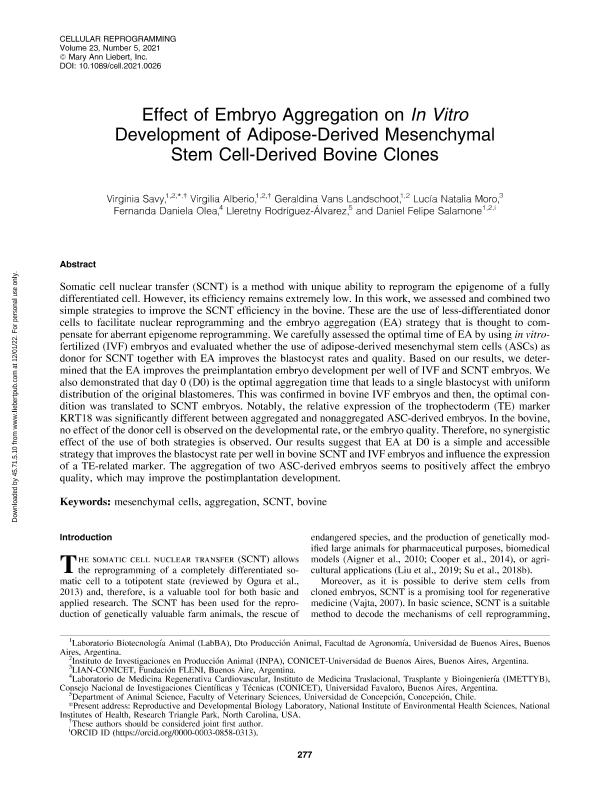Mostrar el registro sencillo del ítem
dc.contributor.author
Savy, Virginia

dc.contributor.author
Alberio, Virgilia

dc.contributor.author
Vans Landschoot, Geraldina

dc.contributor.author
Moro, Lucía Natalia

dc.contributor.author
Olea, Fernanda Daniela

dc.contributor.author
Rodríguez Álvarez, Lleretny
dc.contributor.author
Salamone, Daniel Felipe

dc.date.available
2022-12-01T11:31:32Z
dc.date.issued
2021-10
dc.identifier.citation
Savy, Virginia; Alberio, Virgilia; Vans Landschoot, Geraldina; Moro, Lucía Natalia; Olea, Fernanda Daniela; et al.; Effect of Embryo Aggregation on in Vitro Development of Adipose-Derived Mesenchymal Stem Cell-Derived Bovine Clones; Mary Ann Liebert Inc.; Cellular Reprogramming; 23; 5; 10-2021; 277-289
dc.identifier.issn
2152-4971
dc.identifier.uri
http://hdl.handle.net/11336/179702
dc.description.abstract
Somatic cell nuclear transfer (SCNT) is a method with unique ability to reprogram the epigenome of a fully differentiated cell. However, its efficiency remains extremely low. In this work, we assessed and combined two simple strategies to improve the SCNT efficiency in the bovine. These are the use of less-differentiated donor cells to facilitate nuclear reprogramming and the embryo aggregation (EA) strategy that is thought to compensate for aberrant epigenome reprogramming. We carefully assessed the optimal time of EA by using in vitro-fertilized (IVF) embryos and evaluated whether the use of adipose-derived mesenchymal stem cells (ASCs) as donor for SCNT together with EA improves the blastocyst rates and quality. Based on our results, we determined that the EA improves the preimplantation embryo development per well of IVF and SCNT embryos. We also demonstrated that day 0 (D0) is the optimal aggregation time that leads to a single blastocyst with uniform distribution of the original blastomeres. This was confirmed in bovine IVF embryos and then, the optimal condition was translated to SCNT embryos. Notably, the relative expression of the trophectoderm (TE) marker KRT18 was significantly different between aggregated and nonaggregated ASC-derived embryos. In the bovine, no effect of the donor cell is observed on the developmental rate, or the embryo quality. Therefore, no synergistic effect of the use of both strategies is observed. Our results suggest that EA at D0 is a simple and accessible strategy that improves the blastocyst rate per well in bovine SCNT and IVF embryos and influence the expression of a TE-related marker. The aggregation of two ASC-derived embryos seems to positively affect the embryo quality, which may improve the postimplantation development.
dc.format
application/pdf
dc.language.iso
eng
dc.publisher
Mary Ann Liebert Inc.
dc.rights
info:eu-repo/semantics/openAccess
dc.rights.uri
https://creativecommons.org/licenses/by-nc-sa/2.5/ar/
dc.subject
AGGREGATION
dc.subject
BOVINE
dc.subject
MESENCHYMAL CELLS
dc.subject
SCNT
dc.subject.classification
Tecnologías que involucran la manipulación de células, tejidos, órganos o todo el organismo

dc.subject.classification
Biotecnología de la Salud

dc.subject.classification
CIENCIAS MÉDICAS Y DE LA SALUD

dc.title
Effect of Embryo Aggregation on in Vitro Development of Adipose-Derived Mesenchymal Stem Cell-Derived Bovine Clones
dc.type
info:eu-repo/semantics/article
dc.type
info:ar-repo/semantics/artículo
dc.type
info:eu-repo/semantics/publishedVersion
dc.date.updated
2022-09-22T00:40:06Z
dc.identifier.eissn
2152-4998
dc.journal.volume
23
dc.journal.number
5
dc.journal.pagination
277-289
dc.journal.pais
Estados Unidos

dc.journal.ciudad
New York
dc.description.fil
Fil: Savy, Virginia. Consejo Nacional de Investigaciones Científicas y Técnicas. Oficina de Coordinación Administrativa Parque Centenario. Unidad Ejecutora de Investigaciones en Producción Animal. Universidad de Buenos Aires. Facultad de Ciencias Veterinarias. Unidad Ejecutora de Investigaciones en Producción Animal; Argentina
dc.description.fil
Fil: Alberio, Virgilia. Consejo Nacional de Investigaciones Científicas y Técnicas. Oficina de Coordinación Administrativa Parque Centenario. Unidad Ejecutora de Investigaciones en Producción Animal. Universidad de Buenos Aires. Facultad de Ciencias Veterinarias. Unidad Ejecutora de Investigaciones en Producción Animal; Argentina
dc.description.fil
Fil: Vans Landschoot, Geraldina. Consejo Nacional de Investigaciones Científicas y Técnicas. Oficina de Coordinación Administrativa Parque Centenario. Unidad Ejecutora de Investigaciones en Producción Animal. Universidad de Buenos Aires. Facultad de Ciencias Veterinarias. Unidad Ejecutora de Investigaciones en Producción Animal; Argentina
dc.description.fil
Fil: Moro, Lucía Natalia. Consejo Nacional de Investigaciones Científicas y Técnicas; Argentina. Fundación para la Lucha contra las Enfermedades Neurológicas de la Infancia; Argentina
dc.description.fil
Fil: Olea, Fernanda Daniela. Consejo Nacional de Investigaciones Científicas y Técnicas. Oficina de Coordinación Administrativa Houssay. Instituto de Medicina Traslacional, Trasplante y Bioingeniería. Fundación Favaloro. Instituto de Medicina Traslacional, Trasplante y Bioingeniería; Argentina
dc.description.fil
Fil: Rodríguez Álvarez, Lleretny. Universidad de Concepción; Chile
dc.description.fil
Fil: Salamone, Daniel Felipe. Consejo Nacional de Investigaciones Científicas y Técnicas. Oficina de Coordinación Administrativa Parque Centenario. Unidad Ejecutora de Investigaciones en Producción Animal. Universidad de Buenos Aires. Facultad de Ciencias Veterinarias. Unidad Ejecutora de Investigaciones en Producción Animal; Argentina
dc.journal.title
Cellular Reprogramming
dc.relation.alternativeid
info:eu-repo/semantics/altIdentifier/doi/http://dx.doi.org/10.1089/cell.2021.0026
dc.relation.alternativeid
info:eu-repo/semantics/altIdentifier/url/https://www.liebertpub.com/doi/10.1089/cell.2021.0026
Archivos asociados
